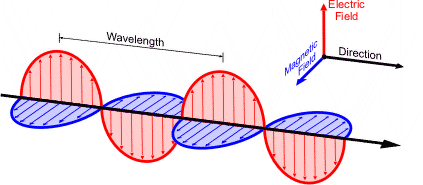Key Concepts
A disturbance of the electromagnetic field, typically produced by the acceleration of an electrically charged object, which propagates as a wave. Electromagnetic waves consist of oscillating electric field and magnetic field components that form self-propagating, traveling waves (see illustration). The wide wavelength range over which electromagnetic waves can exist is known as the electromagnetic spectrum. This spectrum extends from the longest wavelength (and therefore the lowest frequency and lowest energy) to the shortest wavelength (and therefore the highest frequency and highest energy) in the following order: radio waves, infrared waves, visible light, ultraviolet rays, x-rays, and gamma rays. Fundamentally, electromagnetic waves obey the laws of quantum electrodynamics and consist of massless, uncharged, quantum packets known as photons. Electromagnetic waves are also referred to as electromagnetic radiation or light. See also: Electric field; Electromagnetic field; Electromagnetic radiation; Electromagnetism; Elementary particle; Fundamental interaction; Light; Magnetism; Photon; Physics; Quantum mechanics; Spectrum; Wavelength

An electromagnetic wave is created when an object with electric charge or magnetic moment experiences acceleration. Such an acceleration can take the form of linear acceleration, centripetal acceleration, oscillatory acceleration, and thermal motion. Electromagnetic waves can also be created in high-energy particle collisions. Electromagnetic waves may be transmitted through a vacuum, through transparent materials, through waveguides, along transmission lines, or across surfaces. In a vacuum, all forms of electromagnetic radiation travel at the speed of light, c. See also: Acceleration; Electric charge; Electromagnetic wave transmission; Waveguide
Electromagnetic waves were first theoretically predicted in 1864 by Scottish physicist James Clerk Maxwell, who unified all the classical laws of electricity and magnetism into one complete set known as Maxwell’s equations. In the process, Maxwell correctly proposed that visible light is a type of electromagnetic wave. Maxwell’s predictions were verified experimentally by German physicist Heinrich Hertz in 1887. See also: Maxwell's equations





